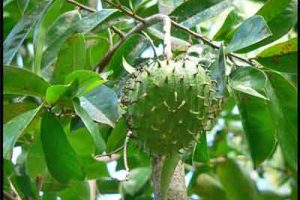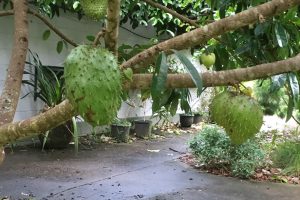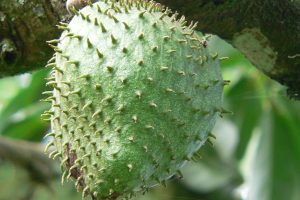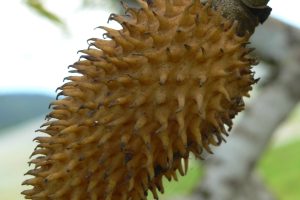Annona muricata
Soursop, guanabana
Origin
It is thought that it originated in the Caribbean Islands and central America, but is now cultivated widely in many tropical regions of the world.
Climate
It is the most tropical of all the Annonaceae, the custard apple Family. Below a mean minimum temperature of 15-25°C trees produce almost no fruit. They also will underperform if temperature and humidity is outside that preferred ie >30°C and less than 30% respectively. Young trees are killed by only a light frost and larger trees may defoliate.
Plant Description
A small evergreen fast-growing tree, 4-8m tall. The smooth dark green glossy alternate leaves are obovate-elliptic, 6-18cm long., dark green above, paler and dull below. It has a shallow fibrous root system.
Relatives
The Annona Family is large with many edible species.
Soils
It prefers deep, rich, well-drained semi-dry soil, but can cope with a wide range of soil types, including acid and sandy soil and limestone. Optimum pH is 5-6.5. Waterlogging is not tolerated.
Propagation
Usually they are propagated by seeds but vegetative techniques, mainly grafting, are used to preserve favourable traits.
Cultivars
Seedling soursops can be quite fibrous, but in some cvs such as the Cuban Fibreless this is much reduced.
Flowering and Pollination
The flowers, solitary but sometimes in small clusters, are 2.5-4cm long, perfect and have 3 thick yellow-green outer petals alternating with 3 pale yellow ones. They exhibit protogynous dichogamy with only marginal overlap and this promotes cross pollination. Flowering can extend for 3-4 months. If you only have a single tree this problem can be addressed by hand pollination. In Australia, fruits tend to ripen beginning in April. Insects are the main pollinators; wind and selfpollination account for only 1-2%.
Cultivation
Dry periods during flowering, fruit set and maturation should be addressed with irrigation. NPK, given as two applications per year, should increase with tree size and production. Zinc deficiency is common and may be corrected with a zinc sulphate spray. Mulching is helpful.
Wind Tolerance
Resistance to wind is not good and they can suffer branch breakages. Protection with windbreaks also improves yield.
Pruning
Their natural shape is conical with a central leader but the vase shape, 2-2.5m high, can be used to improve access, spraying etc. Minimal mature pruning, usually after harvest, is the normal removal of dead, weak or leggy branches; if too severe, subsequent fruiting will be impacted.
The Fruit
It is an ovoid-ellipsoid syncarp that is frequently irregularly shaped and can weigh up to 5kg. Poor pollination of individual ovules resulting in their reduced growth causes the irregularities and usually also smaller size. The skin is dark green with many soft spines, 5-10mm apart, and it turns a yellow-green with ripening. The ripe pulp which adheres to the skin is creamy-white, juicy, aromatic with a cottony-fibrous texture and surrounds many black seeds, 2cm long. The fruit has a good level of Mg, some vitamin C and contains 18% carbohydrates.
Fruit Production and Harvesting
Four-year-old trees can produce 40kg/tree pa, with double the yield when older. The maturation period is normally 16-25 weeks but this may be extended with temperatures below 13°C. The fruit is picked when fully grown and still firm but slightly yellow-green. If allowed to soften on the tree, it will fall and crush. It is easily bruised or punctured and must be handled with care. The soft, pliable spiny projections on the skin break off easily when the fruit is fully ripe. Fruit will ripen in 6-7 days at ambient temperature. Storage below 15°C will cause chill injury.
Fruit Uses
Soursops are usually eaten fresh or processed into juices, purees, ice cream, desserts, jams and jellies. One advantage over its more universally favoured relative – the atemoya – is that it has fewer seeds. Edible flesh is about 70% of the whole fruit.
Pests and Diseases
Mealy bugs, scales, spider mites and weeds, especially with young plants. Diseases can include anthracnose, root rot, bacterial wilt, black canker and purple blotch (Phytophthora spp).
Comments
The biggest challenge in growing this species in the Perth surrounds is trying to match its native climatic conditions. You might have difficulty sourcing named cvs rather than seedlings.



